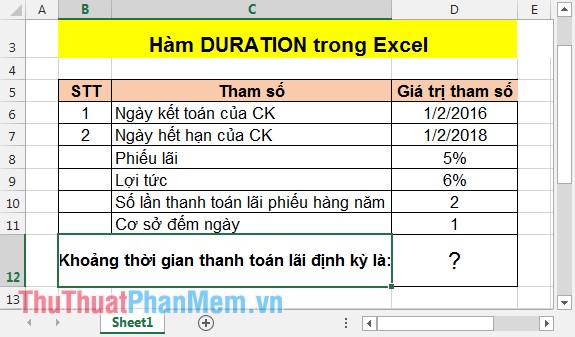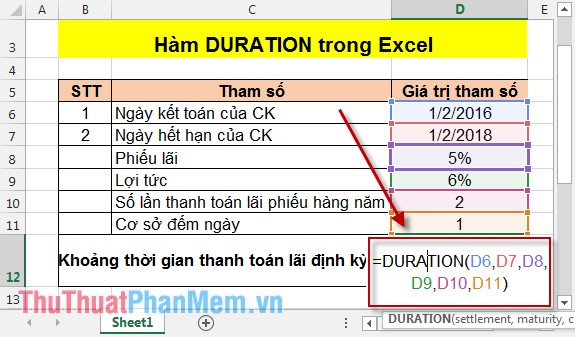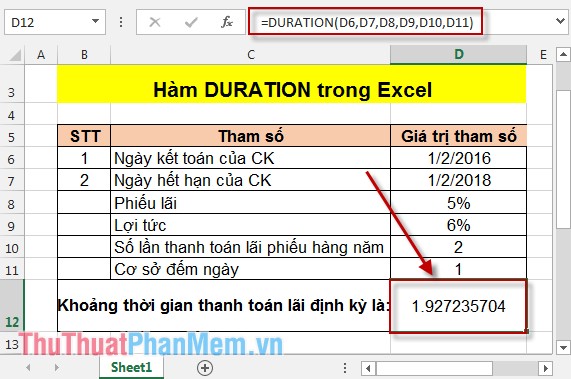DURATION function - The function returns the periodic periodic interest payments in Excel
The following article details how to use the DURATION function to determine the period of periodic interest payment.
Description: The function that returns the validity of a bond is a weighted average of the current value of the cash flow.
Syntax: DURATION (settlement, maturity, coupon, yld, frequency, [basis]) .
Inside:
- settlement : The settlement date of a security is the date securities are sold to buyers after the issuance date, which is a required parameter.
- maturity : The expiry date of the stock, or the maturity date, is a required parameter.
- Coupon : The annual coupon rate of the security, is a required parameter.
- yld : Annual profit of the securities, is a mandatory parameter.
- frequency : Number of interest payment times per year, a required parameter.
- basis : The basis determined to calculate the number of days, is an optional parameter. The following values are available:
+ basis = 0: Calculates the number of days according to US standards, the number of days / year is 30/360.
+ basis = 1: The number of days / year is the actual number of days on the month / number of actual days per year.
+ basis = 2: The number of days / year is the actual number of days on the month / days on the year is 360.
+ basis = 3: The number of days / year is the actual number of days on the month / days on the year is 365.
+ basis = 4: Calculating the number of days according to European standards, the number of days / year is 30/360.
Attention:
- If the input parameters are decimal numbers => the function takes an integer part of the parameters.
- If the settlement date and expiry date of the CK are invalid => The function returns the error value #VALUE !.
- If coupon The function returns the #NUM error value.
- If frequency is outside the value set {1, 2, 4} => returns the #NUM! Error value
- If basis is outside the value set {0, 1, 2, 3, 4} => returns the #NUM! Error value
- If the expiration date is less than the settlement date => the function returns the #NUM! Error value.
For example:
With the following table, calculate the period of time to pay interest annually.

In the cell to calculate enter the following formula: = DURATION (D6, D7, D8, D9, D10, D11) .

After pressing Enter the result is:

Thus, the term of bonds with the above terms is 1,927235704.
Above is the instruction for using the DURATION function.
Good luck!
You should read it
- Enable / disable Periodic Scanning feature on Windows 10
- FVSCHEDULE function - Returns the future value of an investment that has variable or adjustable interest in period in Excel
- PMT function in Excel - Usage and examples
- How to use the IF function in Excel
- GEOMEAN function - The function returns the average of a positive array or range of data in Excel
- How to use the IFS function in Excel 2016
- CHISQ.TEST function - The function returns the independence test in Excel
- DAYS360 function - The function returns the number of days between 2 dates, based on 360 days in Excel
May be interested
- CUMIPMT function - The function of calculating accrued interest in Excel
 the following article is to use cumipmt function to calculate accrued interest. it helps you plan the lowest interest rate payment plan.
the following article is to use cumipmt function to calculate accrued interest. it helps you plan the lowest interest rate payment plan. - GAMMA function - The function returns the gamma function value in Excel
 gamma: the function returns the gamma function. support functions from excel 2013 onwards. syntax: gamma (number)
gamma: the function returns the gamma function. support functions from excel 2013 onwards. syntax: gamma (number) - POISSON.DIST function - The function returns the Poisson distribution in Excel
 poisson.dist function: the function returns the poisson distribution, the application function to predict the number of events in a specific time. support functions from excel 2013 onwards. syntax: poisson.dist (x, mean, cumulative)
poisson.dist function: the function returns the poisson distribution, the application function to predict the number of events in a specific time. support functions from excel 2013 onwards. syntax: poisson.dist (x, mean, cumulative) - WEIBULL function - The function returns the Weibull distribution in Excel
 the function performs the calculation and returns the weibull distribution. based on this distribution to analyze reliability in theory such as calculating the average life of the device or used in the field of meteorology, hydrology and weather forecast.
the function performs the calculation and returns the weibull distribution. based on this distribution to analyze reliability in theory such as calculating the average life of the device or used in the field of meteorology, hydrology and weather forecast. - QUARTILE.EXC function - The function returns the quartile of a dataset without values 0 and 1 in Excel
 quartile.exc function: the function returns the quartile of the data set, with percentile values from 0 to 1 excluding 0 and 1. the support function is from excel 2010 onwards. syntax: quartile.exc (array, quart)
quartile.exc function: the function returns the quartile of the data set, with percentile values from 0 to 1 excluding 0 and 1. the support function is from excel 2010 onwards. syntax: quartile.exc (array, quart) - PHI function - The function returns the value of the density function for a normal distribution in Excel
 phi function: the function returns the value of the density function for a standard normal distribution. support functions from excel 2013 onwards. syntax: phi (x)
phi function: the function returns the value of the density function for a standard normal distribution. support functions from excel 2013 onwards. syntax: phi (x) - FORECAST function - The function returns a value along a linear trend in Excel
 forecast function: the function performs the calculation or prediction of a future value by using current values using linear regression. in excel 2016 this function is replaced by forecast.linear function. syntax: forecast (x, known_ys, known_xs)
forecast function: the function performs the calculation or prediction of a future value by using current values using linear regression. in excel 2016 this function is replaced by forecast.linear function. syntax: forecast (x, known_ys, known_xs) - BETA.DIST function - The function returns the Beta distribution in Excel
 beta.dist function: the function returns the beta distribution to study the variability of a number of things through a sample. support functions from excel 2010 onwards. syntax: beta.dist (x, alpha, beta, cumulative, [a], [b])
beta.dist function: the function returns the beta distribution to study the variability of a number of things through a sample. support functions from excel 2010 onwards. syntax: beta.dist (x, alpha, beta, cumulative, [a], [b]) - How to use the IFS function in Excel 2016
 the ifs function in excel is a logical function introduced in excel 2016. this function is a function that replaces the nested if function and is much easier to use. the ifs function checks one or more conditions and returns a value that meets the first true condition.
the ifs function in excel is a logical function introduced in excel 2016. this function is a function that replaces the nested if function and is much easier to use. the ifs function checks one or more conditions and returns a value that meets the first true condition. - FTEST function - The function returns the result of an F-Test in Excel
 the following article details how to use ftest - the function returns the result of an f-test. in statistical probability, the determination of the correctness and the deviation between two data samples is a regular and extremely important job.
the following article details how to use ftest - the function returns the result of an f-test. in statistical probability, the determination of the correctness and the deviation between two data samples is a regular and extremely important job.










 EFFECT function - The function of calculating the annual real interest rate in Excel
EFFECT function - The function of calculating the annual real interest rate in Excel NORMDIST function - The function returns the normal distribution with the standard deviation and the average value specified in Excel
NORMDIST function - The function returns the normal distribution with the standard deviation and the average value specified in Excel NORMSDIST function - The function returns the normal cumulative distribution in Excel
NORMSDIST function - The function returns the normal cumulative distribution in Excel SUBSTITUTE function - The function replaces text strings in Excel
SUBSTITUTE function - The function replaces text strings in Excel CHITEST function - The function returns the independence test in Excel
CHITEST function - The function returns the independence test in Excel ISPMT function - The function that calculates interest for a specified period in Excel
ISPMT function - The function that calculates interest for a specified period in Excel